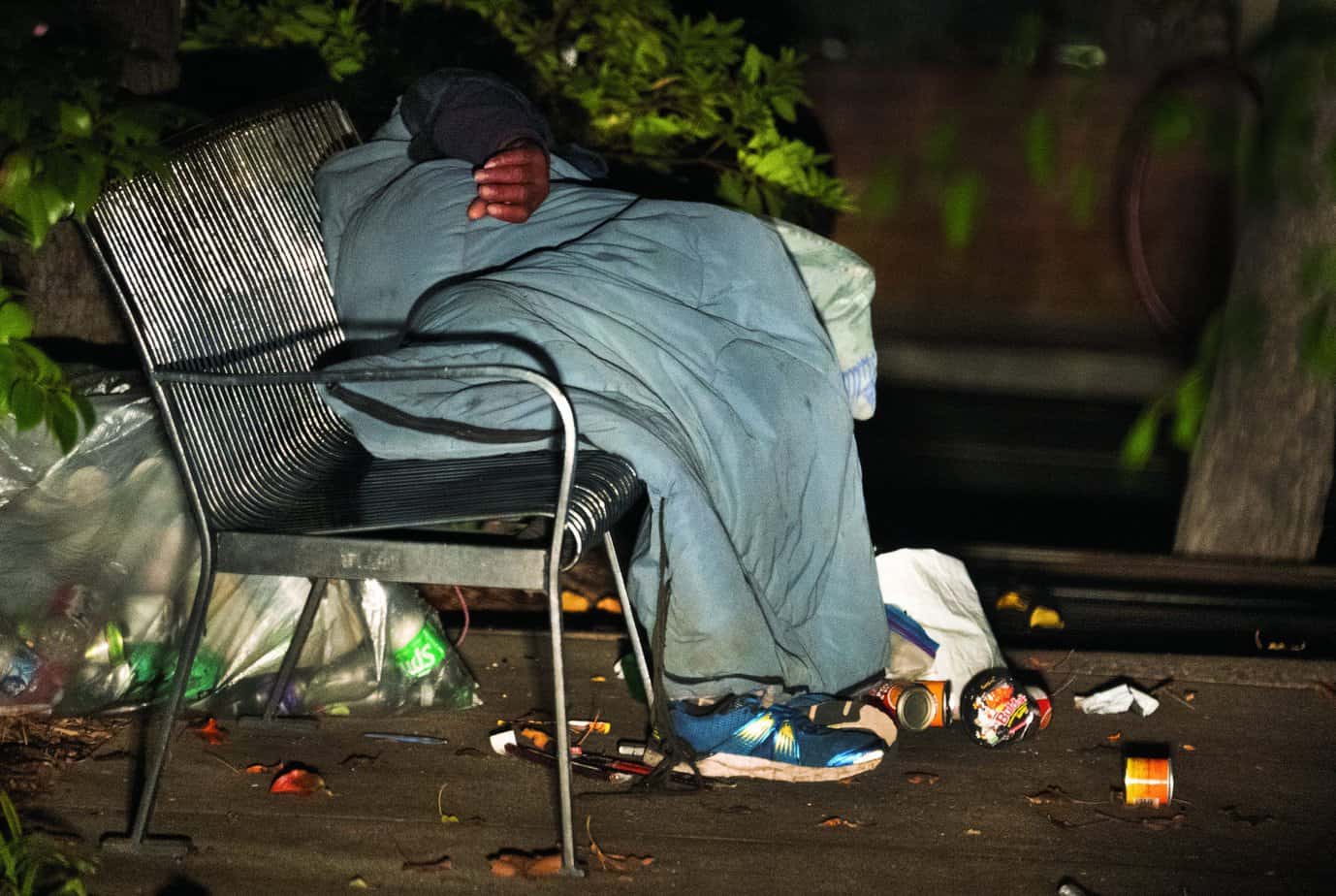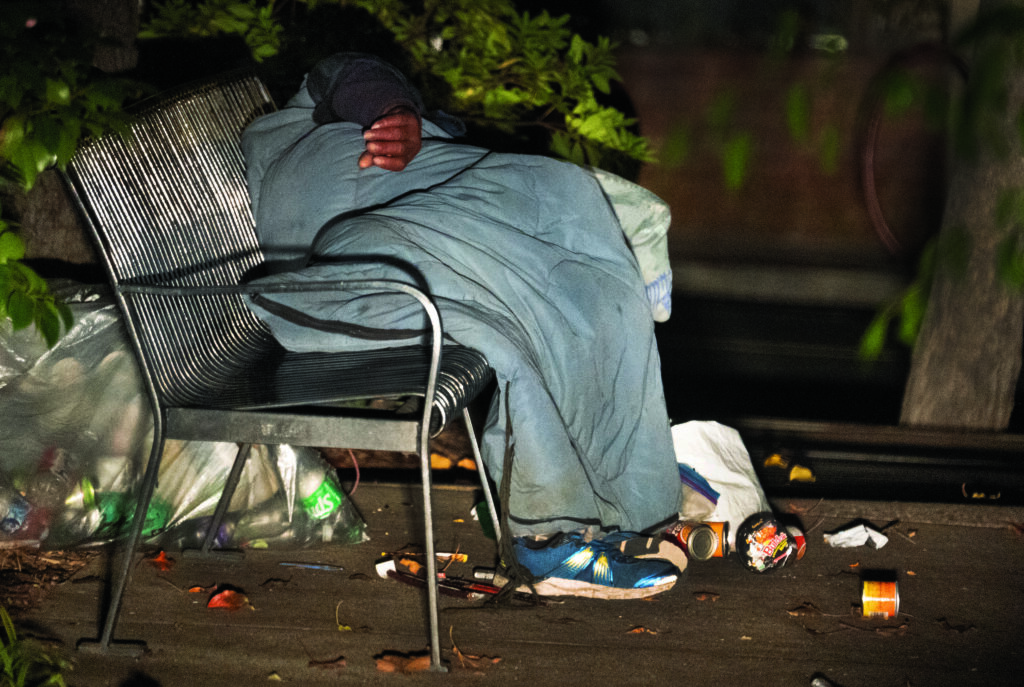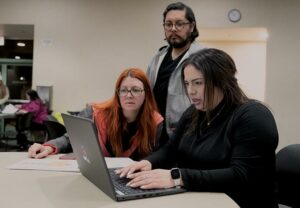Quantifying misery: volunteers count Claremont’s unhoused

An unhoused person rests on a bench Tuesday in the breezeway between Narmoune Salon and the vacant Press bar and restaurant on Harvard Avenue. Courier photo/Andrew Alonzo
by Andrew Alonzo | aalonzo@claremont-courier.com
On Tuesday evening about 20 Claremonters volunteered to search streets, alleyways, sidewalks, parks and other common areas to count the city’s unhoused population as part of the 2023 Greater Los Angeles Point-in-Time homeless count.
The count began at 8 p.m. at the Alexander Hughes Community Center, where materials and 15 service maps were distributed among 11 teams. The Courier was partnered with Claremont resident and volunteer Rachel Forester and her husband, George Ambrocio in service area three, which included the Village, south Foothill Boulevard between Towne and Dartmouth avenues, and areas along First Street and Indian Hill Boulevard. After a three-and-a-half-hour search yielded six unhoused people, the team returned to home base.
“You can’t serve what you don’t know is there,” Forester said. “This kind of data makes it so we can say ‘This is where we need to build this,’ ‘This is where we need mental health services.’ These kinds of counts really give us that ability to ask for the money and funding that we need.”
“Doing this makes it so you get to see first-hand how a lot of these people are affected, where they’re living,” added Ambrocio. “Often times you just think of them as just going to shelters or something. But if you see them on the street, it is more eye opening.”

An unhoused person rests on a bench Tuesday in the breezeway between Narmoune Salon and the vacant Press bar and restaurant on Harvard Avenue. Courier photo/Andrew Alonzo
Jon Deutsch, Los Angeles Homeless Services Authority community relations coordinator for metro Los Angeles, said the count is an inexact science. “The idea is to capture an estimate on any given night in that area,” he said, adding it also “gives us an idea on a larger scale where [allocated resources] are headed.”
Following the tally the Courier talked to a local unhoused man David Briggs, who was sitting on a bench at the Claremont Transit Center on First Street.
“It’s one of those things we like to measure ourselves,” Briggs said. “Whether it does something or not is another question. Do you make another program that minimally meets the needs of some sort of niche population of homeless?
“There’s no real vision. It’s semi-science. It’s trying to get a handle on something that’s not well done.”

An unhoused person and his shoes lie outside Claremont Helen Renwick Library on Harvard Avenue on Tuesday. Courier photo/ Andrew Alonzo
Briggs has been unhoused for about a year following the death of his wife last February, and has since frequented Claremont and Upland. A Christian, Briggs’ said a weekly Bible study in Upland and feelings for his peers keeps him going.
“I knew that I could help out here,” he said. “I got food. I’ve got clothing. I got extra blankets. And I’ve got a lot of good advice.
“I’m the old guy.”
Asked if there is anything specific the community can do to help the local unhoused population, Briggs suggested changing our perception of the unhoused.
“They’re just ordinary people,” he said. “When somebody says hi to you, you can say hi back. You can have a conversation even if you wanted to … showing you that the other person is a person and not just an invisible speck somewhere.”
The count is mandated by the United States Department of Housing and Urban Development and is critical factor in how federal funds intended to aid the unhoused community are allocated. Results will not be available until late spring or early fall. For data updates, visit lahsa.org, call (213) 683-3333 or email communications@lahsa.org.
The annual count, facilitated by the Los Angeles Homeless Services Authority, spanned from Tuesday to Thursday and encompassed all incorporated and unincorporated areas of L.A. County.

Claremont Human Services Department administrative assistant Patricia Cisneros, right, helps 2023 Greater Los Angeles Point-in-Time homeless count volunteers Rachel Forester and George Ambrocio input data gathered at Tuesday’s tally. Courier photo/Andrew Alonzo
Tallies took place throughout the week in the San Gabriel and San Fernando and valleys, East and West Los Angeles, south and metro L.A., and the Antelope Valley. The count will also include a youth tally, which will be conducted through January 31; demographic surveys facilitated by the University of Southern California; and a housing inventory count of those living in interim and permanent supportive housing.
Last year’s tally found 26 unhoused persons in Claremont, with three people living in cars, two inside a recreational vehicle, four in makeshift shelters, and 17 on the streets. The 2020 and 2021 counts were cancelled due to Covid concerns.
Forester and Ambrocio agree the problem can’t begin to be solved until the hard work — like counting the unhoused population — is done.
“These kinds of tangible events … they ground you and center you and remind you what we’re actually doing,” Forester said. “It’s really important to remember the humanity of this. These are our neighbors and just because they don’t have a permanent address or a roof over their head, they are still members of our community.
“We’re a community. If one person isn’t doing well, our entire community isn’t doing well.”
To propel change, Briggs issued two community challenges. Residents can donate money to one of the first unhoused persons they greet, or read two books: “Atomic Habits: An Easy and Proven Way to Build Good Habits and Break Bad Ones,” by James Clear, and “Dopamine Nation: Finding Balance in the Age of Indulgence,” by Anna Lembke.
“If you read those two books, you’ll learn a lot about why you have bad habits and also why other people have bad habits,” Briggs said.
For information on LAHSA or the 2023 count, visit lahsa.org/homeless-count.









0 Comments